(2 comments.)
This is an informational website about cymbals imported from China for American drum sets in the early part of the Twentieth Century. I am researching their history, for I don’t find them well described in the English literature. My friend and colleague Carol Huang has provided all of the translations below:
Suzhou Cymbals – early 1900s (?)
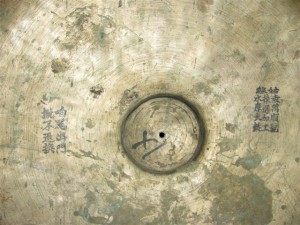 |
Underside of a 20.5″ China cymbal purportedly from around the year 1900.
| 姑酥 |
The ancient name of Su Chou, or Suzhou, city where the cymbal was made. |
| 袁萬順號 |
The store or the manufacturer who made the cymbal. |
| 揀選加工 |
Exclusive selection by the manufacturer before additional work (?) |
| 水磨天鈴—– |
The name of this type of cymbal: “water polished cymbal”? |
On the left hand side:
| 響器 出門—– |
Once the cymbal is out of the door (once it is sold.) |
| 概不退換 |
there will be no exchange. |
|
The following is from a 14″ cymbal reportedly dating to the early 1900s. Unknown.
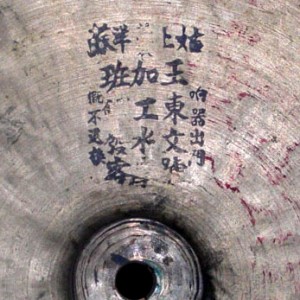 |
| 姑酥 |
(top words) Su Chou, or Suzhou, the city where the cymbal was made, |
| 上洋 |
the specific location in the city, near Guangzhou. |
| 王加班 |
Wang’s family business. |
| 東文號 |
Might be the name of the story(?) |
| 水磨發客 |
This is a “Water polished cymbal” (?) |
| 響器 出門 |
Once the cymbal is out of the door (once it is sold.) |
| 概不退換—– |
there will be no exchange. |
|
記瑞 Rui Ji – 1914-1930s
記瑞 Rui Ji (Van Jau & Co.) – later 1910s/20s?
The underside from this era contains a stamp that romanized Wan Ju as “Van Jau & Co.” Whereas the earlier stamps were only Chinese, these cymbals use Chinese and English too.
記瑞 Rui Ji (Made in China) – 1920s/30s?
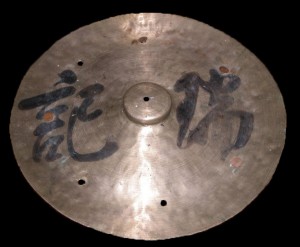 |
記瑞—–Ruì Jì
The underside of the cymbal lacks the earlier stamp, so now it just says “Made in China” or simply “China”.
The diameter of the cymbals are marked with something similar to Chinese numbers. The Chinese for eleven is 十一, twelve 十二, thirteen 十三, fourteen 十四, fifteen 十五…?
|
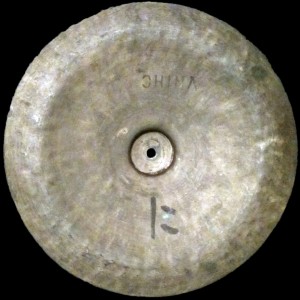 |
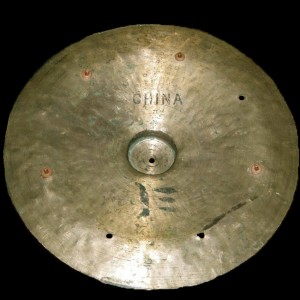 |
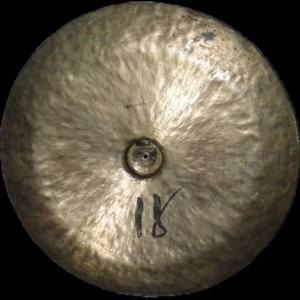 |
| 12″ cymbal |
13″ cymbal |
15″ cymbal |
Pacific commerce was greatly interrupted during World War II. In 1937, China went to war with Japan, and during 1938 much of China was occupied by Japan. It would be useful to find a Ludwig catalog from the 1930s to see if Chinese cymbals from China are offered. After World War II, China-type cymbals were manufactured by Zildjian and Paiste, American and European companies that replaced the Chinese import market until the introduction of Wuhan cymbals in the 1960s.
Old Wuhan Cymbals – 1960s-1970s
Wuhan cymbals were sold in small numbers in the 1960s and 1970s. The following article states that the factory in Wuhan produced cymbals for thousands of years and, until the 1960s, was known as “the Gaohongtai factory” (p. 30). It also refers to “problems of restricted availability” of the cymbals in 1982 (p. 31).
Howard, Bruce. 1982. Wuhan gongs and cymbals: Maintaining an ancient tradition. Modern Drummer 6(2): 30-31, 92.
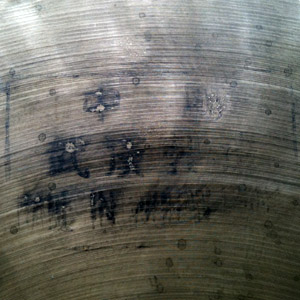 |
Old Wuhan cymbals have a rectangular ink stamp as in this blurred photo. No references to Gaohongtai. No Comic Bubble font reading “WUHAN”.
| 中国 |
China |
| 武汉 ? ?—– |
Wuhan __?__ __?__ |
| English: |
Made in Wuhan China |
|
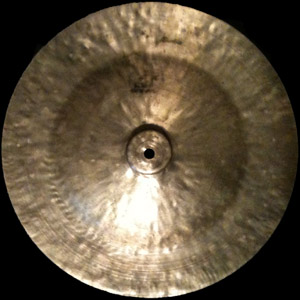 |
The 16″ diameter cymbal with the above stamp. |
Wuhan/Gaohongtai Cymbals – 1980s
Gaohongtai was the traditional name of the factory, but it was re-named Wuhan (after the province where it’s located) during Mao’s Cultural Revolution in the 1960s. In the 1980s, the “Gaohongtai” stamp returned in addition to “Wuhan” stamps. Source: Howard, Bruce. 1982. Wuhan gongs and cymbals: Maintaining an ancient tradition. Modern Drummer 6(2): 30-31, 92.
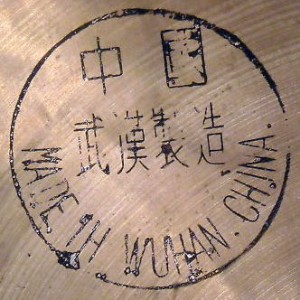 |
Wuhan cymbals from the 1980s had two ink stamps. The “first stamp” to the left is merely a circular version of the more square shaped one from the 1970s.
| 中国 |
China |
| 武汉 ? 造—– |
Made __?__ Wuhan |
| English: |
Made in Wuhan China |
|
 |
This “second stamp” appeared with the above “first stamp” on a cymbal purchased in 1985. It includes the name Gaohongtai. |
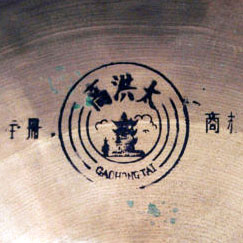 |
Another variation of the “second stamp” from the 1980s. This one from a large 22″ cymbal. |
Next the comic bubble font logo appeared…………..
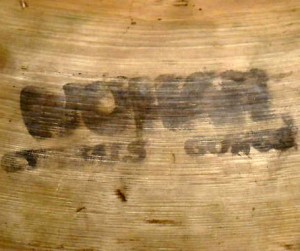 |
This “third stamp” also appeared Wuhan Lion cymbals along with the above stamps in various combinations. Later, it appeared alone, as in this 1980s era Wuhan advertisement. |
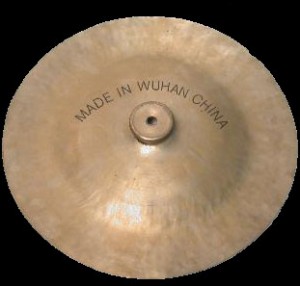 |
I don’t know anything about this stamp. I’ve only seen one that looks like this. |

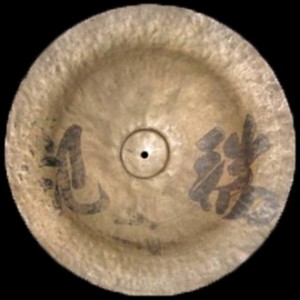
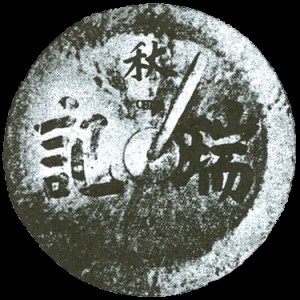
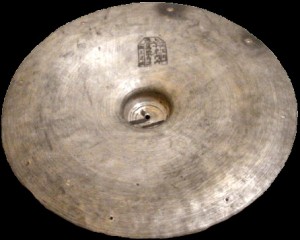
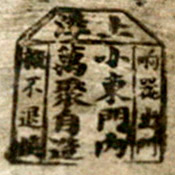
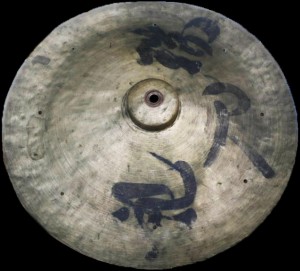
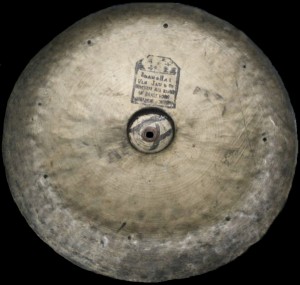
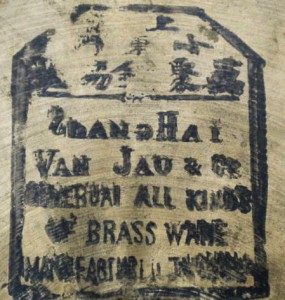












I have a chinese cymbal I purchased a while back from eBay. I mostly got it for decoration and it didn’t cost me very much. After looking at your images above, it has the same exact stamp as the china16.jpg. So I am thinking it is a Wan Ju from Shanghai. It is just over 14″ in diameter, has a smaller than normal hole and the bell cup is about 2 3/8″ inches around. It also appears to have what might be acid etched characters on the topside, none of which match any others on this page. I can send pictures if you’d like.
Best regards,
David
I have cymbals with the post 1960’s round second stamp variation but the other stamp is in a square frame I was wondering if that dated the cymbals closer and if these cymbals have value. I have a whole Chinese New Year Parade ensemble and the cymbals were with it. I have listed them on ebay & I want to do it correctly.
Thanks for the photos, Debbie. These indeed are marching cymbals, thus the fabric to hold on to. With Chinese cymbals, you can also hold onto the bell while playing them unsuspended. These are valuable, probably from the 1960s or 1970s, when fewer were imported for drum sets. They won’t fetch more than $100, I’m afraid.
Oh my youth!! When I was 10 I got an old, old Ludwig Jr. Kit front the lat 19 teens or early 1920’s with a painted front head and it had a China cymbal about 14″ that had the ink writing much like the Rui Ji. Well, I still have the kit some 40 years later well preserved, but the cymbal got unloaded by me to some kid for 50 cents when I sold my crappy old metal shelled toy drum set. I thought the China cymbal was terrible. But it was thing and had a very nice build and roar to it looking back. My modern Wuhan is not even close to it! Well, live and learn. Oh I did keep the stamped and riveted cymbal that the toy kit came with. It sounds pretty good.